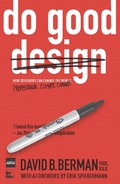
When the First Things First manifesto from 1964 was about to be republished by Adbusters for the new millennium, I readily signed it. As the manifesto put it, “designers... apply their skill and imagination to sell dog biscuits, designer coffee, diamonds, detergents, hair gel, cigarettes, credit cards, sneakers, butt toners, light beer and heavy-duty recreational vehicles.” Who wouldn’t agree with the conclusion that “our skills could be put to worthwhile use”? I signed, because the list of colleagues and friends who had already signed was impressive, even intimidating. And the original signatories from 1964 were pretty much all my heroes.
I did, however, add a paragraph stating slight misgivings. It is easy, after all, to put your name on a list of famous designers and bask in the reflected glow of their presence. But does that change what we would do in our studio the next morning? Would I tell my 70-some employees that from now on, we would be do-gooders only, send our “commercial” clients away and wait for more worthy projects to find the way to our door? Didn’t the other signatories also do work for hire, for clients who use our work to sell more of whatever they are selling? Is all selling bad? Is designing books always good because there are no bad books? Designing signage for a public transit system is good, airport signage is bad because only The Rich can afford to fly? And how about signage for shopping centers? Bad? Amusement parks?
As opposed to architects, who honestly think that the world would cease to exist if they stopped working, we graphic designers know that the world would probably carry on pretty much the same without our services. Things may look a little less colorful and some companies might sell less without our help in communicating their services or goods, but lives will not be lost. There are, however, situations where graphic design, or rather the lack of it, has cost lives. In 1997, a fire raged through Düsseldorf airport in Germany. Thick smoke made it difficult to see the emergency signs, which were also not placed where they should have been, too small, and too badly lit. Sixteen people died because they could not find their way out. As a result, we were hired to not only design new signage that was legible, well-lit, and visually appealing, but we also worked with the planners to make sure the signs were put where they would be visible. The architects wanted the signs “out of the way of the beautiful architecture,” as they put it, which would have repeated the previous mistakes. We had to insist that we were not hired to simply make the place pretty, but actually make the airport function properly. Behaving responsibly is not asked for in Requests for Proposals, but without asking questions that haven’t even been asked, we would just be window dressers.
My first responsibility is to my family and to my extended family, the employees of my studio. They look to me for their livelihood. They all became designers because they wanted to make something – something that was better than what had been there before. Of course we discuss what sort of projects we take on and what type of clients we work for. Some issues are quickly resolved: we wouldn’t work for a cigarette brand, although some of us still smoke. But we have worked for automotive brands, and most of us still have cars, although essentially cars are very, very bad.
Whether what we design is good or bad is difficult to judge. We live in this society, and we benefit from the material wealth it offers. As Max Bill put it, we apply 90 percent of our efforts to making something work, and we should apply the remaining 10 percent to making it beautiful. “Designers have enormous power to influence how we see our world, and how we live our lives,” David writes in this book. I could not agree more, and I think that we all need to be constantly aware of what we do, for whom we work, and how our work affects others. But whatever our good intentions may be, we cannot ignore the reality that design is a business and has to live by the rules of business. As we have seen recently, those rules need to be rewritten. There is hope for more awareness and responsibility, even in the world of commerce that we’d rather not belong to but cannot escape from.
In my 30 years of running a design studio, I have come to the conclusion that there is one thing we can do that nobody can stop us from. We alone decide how we work. Whatever the restrictions and limitations of the commercial world that buys our services, we create our own processes. How we deal with our employees, our suppliers, our clients, our peers, and even our competitors is totally up to us. How we make something is very important, and it is the one thing we can influence without much interference. We’d still have to fill out tax returns, make sure the computers are running and the rent is paid, but the way we work with each other and with our clients is where we can be different. As we take in the big picture of what this book is all about, let’s begin by looking at our immediate reality. Charity starts at home.
Erik Spiekermann is an author, information designer, and typographer. He founded MetaDesign and FontShop, is Honorary Professor at the University of the Arts in Bremen, and has an honorary doctorship from Pasadena Art Center. He was the first designer to be elected into the Hall of Fame by the European Design Awards for Communication Design. He lives and works in Berlin, London, and San Francisco. His studio, Spiekermann Partners, employs 30 designers.
